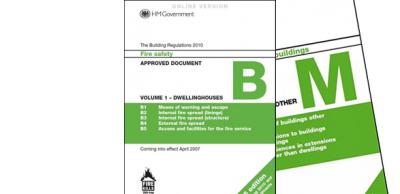Revealed: The value of having an approved set of plans
Local Authority Building Control prevents at least 476,000 things going wrong on site every year before construction even begins.
LABC has released independent research on issues that were found during the routine plan assessments done by local authority building control teams. The research, carried out by Lychgate Projects Ltd, involved a sample of 42 local councils over a 3- week period where a massive 3,973 ‘interventions’ (things wrong) were found on plans, of these, 40% represented a "high risk of failure".
Local authorities have to do these formal plan assessments on full plans building regulations applications. This research has proved that they’re a major contributor in making sure work complies before work begins on site and materials are even bought. This means that plan assessments prevent the wasted time and financial costs of correcting faults that would otherwise happen.
Building Notice applications are frequently used on minor works and the detail is agreed between the contractor and the building control surveyor on site; but this research proves that if you want to make sure you're ordering the right materials and not doing work that’ll have to be undone, the Full Plans Application process is the best way forward.
This research clearly demonstrates the value of the local authority process.
While some do, Approved Inspectors don’t have to assess plans for compliance with the building regulations and if they do, this can be at extra cost. So the local authority service delivers much better value because the plan assessment is included in their building control fee and it prevents issues occurring during construction.
Over half of the interventions recorded related to Part A (Structure) and Part B (Fire Safety) and were classified as a "high" or "intolerable risk", with high numbers of interventions also in Part C (Resistance to Contaminants & Moisture) and Part L (Conservation of Fuel & Power).
When interviewed, 86% of business customers found the LABC network's plan assessment service to be "extremely" or "fairly" useful, and 20% of customers thought the process saved them money by simplifying design and specifications.
The report underpins LABC's belief that plan assessments are vital to improving compliance outcomes.
Other key findings
- The new homes sector accounted for 20.1% of interventions
- 98% of customers said that the plan assessment is a positive step and 88% communicated it to their end-client
- 53% of business customers felt that the advice (interventions) led to a safer builder
Paul Everall, Chief Executive LABC commented on the new research. “This new research shows that we prevent nearly a million faults from occurring during construction. This must be worth millions of pounds to the economy. The plan assessment is successful and critical in ensuring buildings are produced to the right standard and in doing this we also save clients and industry the cost of wasted materials and wasted time.”
Paul continues, “Unfortunately competition in building control is confusing clients. Instead of valuing quality and achieving the right standard, competition is dividing the market with some businesses seeking “the least interference at the lowest price”. Politicians, policy makers and industry really need to reappraise their framework for thinking about us. We are not 'red tape', we add enormous value.”
Sign up to the building bulletin newsletter
Over 48,000 construction professionals have already signed up for the LABC Building Bulletin.
Join them and receive useful tips, practical technical information and industry news by email once every 6 weeks.
Subscribe to the Building Bulletin




Comments
Vitally important
Submitted 6 years 6 months ago
1.) The only thing that matters to developers is money and they will do virtually anything to avoid paying fees.
2.) Clients are just as bad as developers.
3.) From experience private Building Inspectors are forced to cut their fees to get work, and as a consequence they cannot provide an adequate service.More often than not private building control does not carry out anything like enough site inspections,hence the rise over the years of building works that do not comply with the building regulations.
4) Where the client/developer appoints a private building inspector they have total control of the purse strings and are totally ruthless.Although there is corruption in every system it's not as easy when a large body like a local authority is in control.
5) large developers carry for too much weight when it comes to building regulations, fire regulations etc.A balance needs to be reached. Also, politicians should not be involved unless they can evidence of expertise in the construction field.
6) current building regulations/fire regulations need to be rationalised and simplified and then rigourously enforced.
Defects in new buildings are a serious problem.
7) Designers should also be made to be more accountable
when they produce building regulation submission details. Too many designers produce inadequate drawings/designs and expect the local authority to do their job for them. This should not be tolerated by local authorities.
Designers should also be responsible for inspecting the developers/contractor's works at every stage up to completion and for signing them off. 6 site inspections does not enable enable anybody to confirm in writing that the building has been built in accordance with the appropriate regulations.
8) Under the CDM regulations 2015 principal, designers/ builders/developers must produce health and safety files,however, this seems to rarely happen.
Finally, without building regulations/fire regulations being enforced by an independent body, of substance, the problems in the construction industry will never be brought under control, with more and more lives at risk.
Other industries have tight quality controls. So why should the construction industry be any different?.
Why?
Submitted 6 years 6 months ago
A Building Notice means that the design role is taken by the builder and he has taken work away from a designer for a variety of reasons. He should not be allowed to then pass that role on to the BCO. They should be limited to 'yes' or 'no', 'accepted' or 'rejected' responses.
It might be argued that however simple the project the BCO assumes a responsibility for design the moment they stray over the line into design. Who is responsible should that design fail, fall down and injure someone? Does their insurance cover that?
Another point, whilst they are spending longer on a site 'designing' they should be elsewhere.
There is another issue with that scenario in that the BCO is now designing and then approving his own design.
Webmaster note
Submitted 6 years 6 months ago
Add new comment